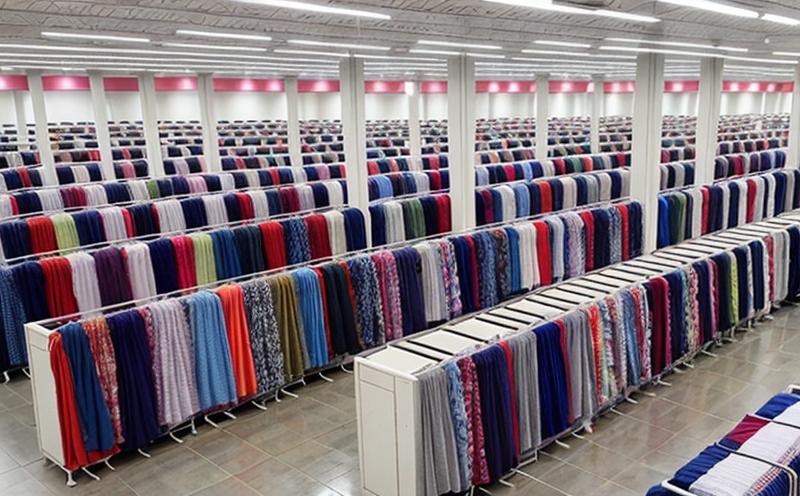ISO 9237 Air Permeability Testing of Fabrics in Export Goods
The ISO 9237 air permeability test is a critical procedure used to evaluate the breathability of fabrics and textiles, which is particularly important for export goods. This standard ensures that products meet the required standards set by international trade regulations, ensuring they are fit for use in various climates.
Textiles with high levels of air permeability allow for better ventilation, making them suitable for a wide range of applications including clothing, bedding, and home textiles. In the context of export goods, understanding how fabrics perform under different environmental conditions is crucial to meet customer expectations and comply with international standards.
The ISO 9237 test measures the amount of air that passes through a specimen of fabric within a specified time period using a predetermined pressure difference across the fabric. This measurement helps manufacturers and exporters understand the breathability properties of their products, which can significantly impact the comfort level for end-users in diverse climates.
The testing procedure involves preparing samples according to ISO 9237 guidelines. Specimens are placed between two chambers separated by a membrane of the same material as the fabric being tested. A controlled pressure difference is then established across this membrane, and air flow through it is measured over time. The results provide a quantitative assessment of the fabric’s breathability.
Understanding the specifics of ISO 9237 testing can help quality managers and compliance officers ensure that their products meet international standards. For R&D engineers, this test is essential for optimizing textile designs to improve air permeability without compromising other desired properties like strength or durability. Similarly, procurement teams benefit from knowing which suppliers offer fabrics with the right breathability characteristics.
The importance of accurate testing cannot be overstated. Inconsistencies in fabric breathability can lead to poor product performance and dissatisfaction among consumers. By adhering strictly to ISO 9237 procedures, laboratories ensure that every sample tested meets rigorous quality standards. This not only enhances the reputation of manufacturers but also builds trust with international buyers who rely on consistent quality across all deliveries.
Compliance with this standard is particularly vital for textile and apparel exports because it ensures that products meet regulatory requirements set by importing countries. Many nations have specific limits or preferences regarding breathability, especially in sectors like sportswear where heat management plays a crucial role.
In summary, ISO 9237 air permeability testing provides valuable insights into the performance of fabrics under controlled conditions, helping stakeholders make informed decisions about material selection and production processes. It supports adherence to international trade regulations while enhancing product quality and customer satisfaction.
Why Choose This Test
- Precise measurement of air permeability as per ISO standards.
- Supports compliance with international export regulations.
- Ensures consistent product quality across all deliveries.
- Improves fabric breathability for enhanced user comfort.
- Aids in optimizing textile designs to meet specific performance needs.
- Facilitates better decision-making during the procurement process.
Quality and Reliability Assurance
Accurate air permeability testing is essential for maintaining high standards of quality and reliability in exported textiles. This ensures that products consistently meet or exceed specified performance criteria, thereby protecting both manufacturers' reputations and consumers' expectations.
The ISO 9237 test provides a standardized method for evaluating how effectively fabrics allow air to pass through them. By adhering strictly to these procedures, laboratories can generate reliable data that accurately reflects the breathability properties of different textile materials.
Quality managers rely on such tests to ensure uniformity in product performance across batches and suppliers. For compliance officers, knowing whether a batch meets international standards helps avoid potential disputes during inspections or audits conducted by importing countries.
R&D engineers benefit from detailed test results that highlight areas for improvement in current designs. They can use this information to innovate new materials or refine existing ones based on real-world performance data rather than theoretical assumptions alone.
For procurement teams, ISO 9237 testing offers assurance about the quality of purchased fabrics before they are incorporated into production processes. This reduces risks associated with substandard raw materials and supports long-term relationships built on trust between suppliers and buyers alike.
In conclusion, reliable air permeability testing using ISO 9237 ensures that exported textiles consistently perform as intended regardless of where or how they are used. It contributes significantly to maintaining global supply chain integrity while fostering continuous improvement within the industry.
Customer Impact and Satisfaction
When it comes to textile and apparel exports, ensuring that fabrics meet specific air permeability standards is crucial for customer satisfaction. Consumers expect products that not only look good but also perform well in terms of comfort and functionality.
Air permeability affects several aspects of fabric performance directly related to user experience. For instance, highly breathable materials are ideal for activewear where sweat management is important. Conversely, less permeable fabrics may be preferred for winter clothing where insulation is key.
Exporters who adhere strictly to ISO 9237 guidelines can demonstrate their commitment to delivering high-quality products that meet or exceed customer requirements. This builds trust and loyalty among international buyers who value consistency in product performance.
Moreover, compliance with these standards helps prevent issues such as premature wear due to improper fabric selection. When fabrics do not perform optimally according to specifications, it can lead to dissatisfaction from end-users leading to negative feedback impacting brand reputation negatively.
In summary, accurate air permeability testing ensures that exported textiles align perfectly with customer expectations enhancing overall satisfaction levels. It supports long-term relationships between manufacturers and buyers by establishing a foundation of reliability built on adherence to internationally recognized standards.





